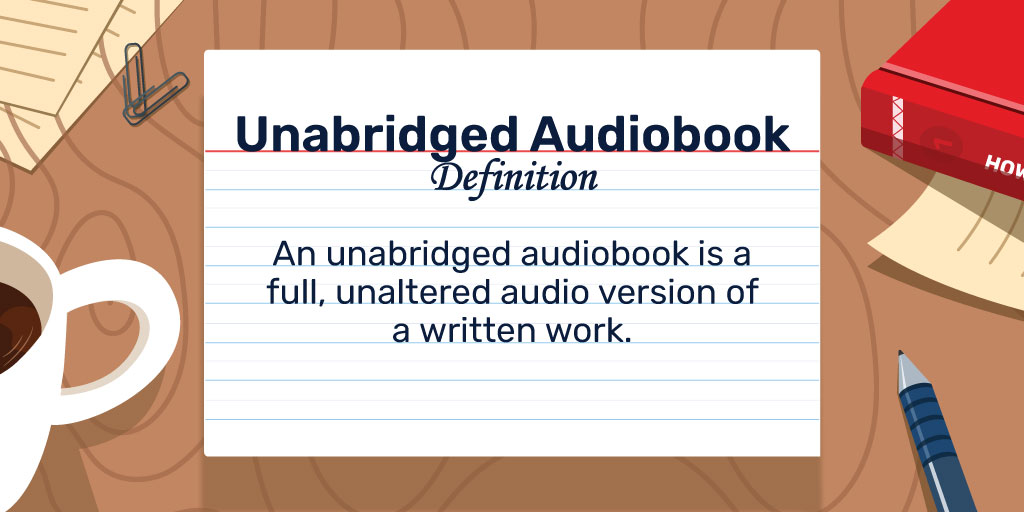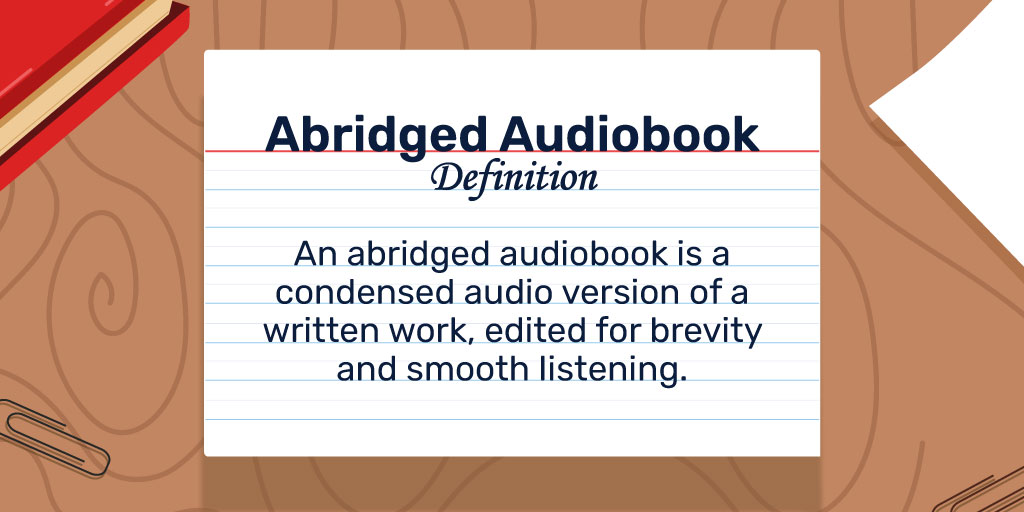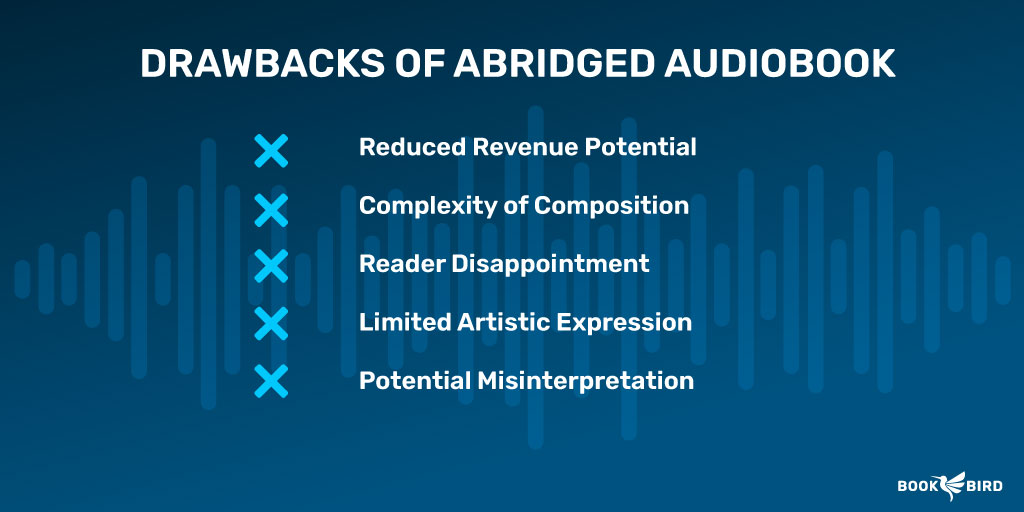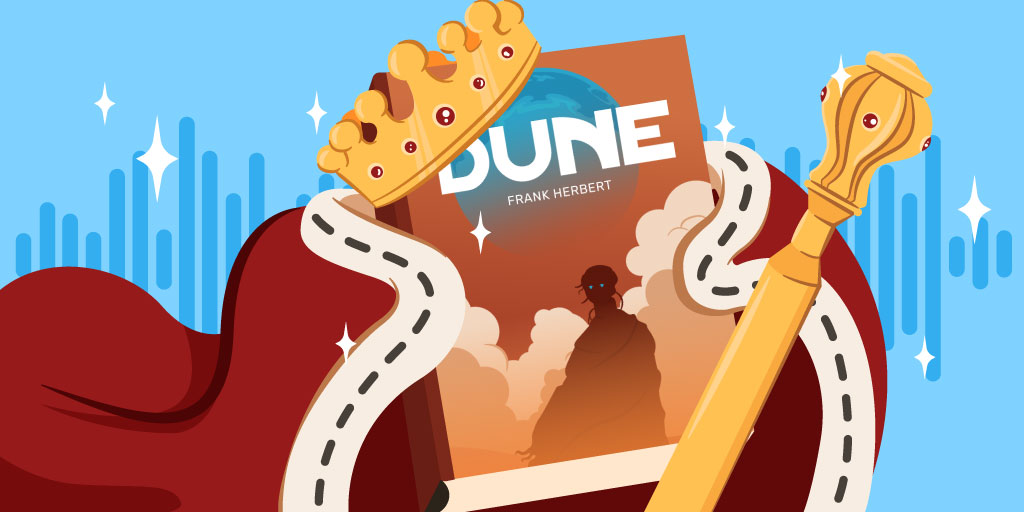In a world where time is a precious commodity, abridged audiobooks are alluring. These condensed editions promise to whisk your readers away on a thrilling journey without demanding hours upon hours of their undivided attention. They offer a tantalizing glimpse into a story’s essence, stripped of excess details and trimmed down to its core.
But is the allure of brevity worth the sacrifice? Enter the realm of unabridged audiobooks, where every word, every nuance, is preserved in its original glory. No scene left unturned; no character left unexplored.
Join us as we investigate the advantages and drawbacks of both approaches to help you decide whether to take the abridged or unabridged route when you publish your own audiobook.
Unabridged vs. Abridged Audiobooks

Unabridged audiobooks faithfully replicate the entire written work. They preserve every paragraph, sentence, and detail, ensuring that no detail is left behind. Abridged editions, on the other hand, condense the content of the original work. They aim to provide a streamlined narrative, focusing on the key plot points, essential story elements, and most important facts.
By preserving the complete narrative, unabridged versions allow for a more natural and unhurried storytelling experience. The pacing mirrors that of the written work, affording the listener the opportunity to savor the author’s prose and immerse themselves fully in the story. Abridged editions sacrifice some of the narrative depth and slower pacing for a quicker, more streamlined pace. They aim to maintain a sense of momentum, condensing the story to keep listeners engaged and entertained.
Due to their comprehensive nature, unabridged versions require a larger time commitment. They are ideal for listeners who crave an enveloping experience and have the luxury of dedicating extended periods to audiobook listening. The shorter duration of abridged editions makes them appealing for listeners with limited time availability, catering to those who want to enjoy a complete story in a more time-efficient manner, fitting audiobooks into busy schedules or shorter commutes.
Let’s take a look at the differences in the following overview:
Characteristic | Unabridged Audiobooks | Abridged Audiobooks |
|---|---|---|
Length and Content | Contains the complete text of the original work | Condensed version, omitting certain scenes and details |
Narrative Pace | Allows for a natural and unhurried storytelling experience | Maintains a quicker, more streamlined pace |
Character Development | Provides in-depth exploration of characters and their growth | Focuses on essential aspects, sacrificing some development |
Time Commitment | Requires a larger time commitment for extended listening | Provides a time-efficient option for listeners with limited time |
Language and Prose | Preserves the author’s original writing style and language | May simplify the original prose or omit certain descriptive language |
Subplots and Side Stories | Includes all subplots and side stories, enhancing depth and complexity | Focuses on the main plot, minimizing subplots and side stories |
Thematic Exploration | Explores a broader range of themes and ideas within the story | Focuses on the central themes with less exploration |
Length of Recording | Requires a longer recording time due to the book length | Involves a shorter production time due to condensed content |
Recording Costs | Involves higher recording costs due to the extended duration | Incurs lower recording costs due to shorter length |
Editing Time and Cost | Requires no extra time and expenditure to cut down the print version | Requires more time and money to produce a slimmed-down version |
Market Demand | Attracts readers seeking complete and comprehensive experiences | Appeals to an audience seeking shorter and time-efficient options |
Price | More expensive | More cost-effective |
What is an Unabridged Audiobook?

An unabridged audiobook refers to a full and unaltered version of a written work that has been read and recorded for audio consumption. It faithfully replicates the entire text, including all chapters, paragraphs, sentences, conflicts, facts, and details, without any significant omissions or alterations.

Unabridged audiobooks aim to provide a comprehensive and immersive listening experience, allowing the audience to fully delve into the author’s original language, prose, character development, worldbuilding, and thematic exploration. They are longer in duration, preserving the intended narrative flow and pacing of the original written work.
They are popular primarily with people who enjoy listening to fiction while driving or performing household chores. But the majority of audiobooks in all categories are currently unabridged.
What is an Abridged Audiobook?

An abridged audiobook is a shorter version of a written work that has been recorded for audio listening, with certain scenes, descriptions, secondary storylines, or non-essential facts omitted to make it more concise, time-efficient, and cost-effective.

The existence of abridged audiobooks can be traced back to the limitations of older recording formats, such as records and tapes, which had limited space to store lengthy stories.
To make audiobooks more accessible and affordable and avoid producing stories that ran over multiple records or tapes, publishers started creating condensed versions of popular novels. This allowed listeners to experience the main plot and key elements without requiring them to lug around big boxes of records or tapes.
As technology advanced with digital formats and streaming services, the industry overcame the problem of limited storage space, but abridged audiobooks continue to be popular with individuals with busy schedules or shorter attention spans.
They are relatively popular with nonfiction readers, people who are new to audiobooks, children who wish to consume simpler versions of stories, and students who want to pass their classes without reading long texts, especially classics.
As such, most available abridged audiobooks are in the categories of business, self-help, religion, spirituality, children’s books, and classics. Although, even in these categories, unabridged versions constitute a majority.
Benefits of Abridged Audiobooks

While abridged audiobooks tend to be less popular than their unabridged cousins, there are circumstances in which you may want to produce an abridged version. Below you will find some of the advantages of abridged audiobooks for authors.
Reduced Recording Time
Because they are shorter, abridged audiobooks require less recording time than unabridged versions. With less content to record and audio to edit, the overall production process can be expedited, allowing for quicker release and turnaround times.
Lower Recording Costs
Abridged audiobooks incur lower recording costs than unabridged versions. With less recording and audio editing required, expenses such as studio time and narration fees can be reduced, making it a more cost-effective option for authors and publishers.
Expanded Market Potential
By condensing books, abridged audiobooks attract readers who don’t have enough time to invest to read the full-length versions. These include children who might still be intimidated by long books and busy professionals who want the essential facts in a concise format.
And authors should not sneer at this market. A strong majority of people are intimidated by the more than 1.2 million words in Mission Earth by L. Ron Hubbard or the almost 600,000 words in Leo Tolstoy’s War & Peace. So if you write a long book, an abridged version can help students, kids, busy adults, and young people with short attention spans to read it.
Introduction to Your Work
For readers who may be new to your work, abridged audiobooks provide a taste of your writing style and storytelling prowess. If captivated by the abridged version, readers may be inclined to explore your unabridged works, increasing interest and book sales.
Improved Writing Skills
As strange as it may seem, producing a slimmed-down version of your book may help you to improve your writing style and editing abilities. Because an abridged version is so narrowly focused on the essentials without the distractions of secondary storylines and details, cutting down your work for an abridged audiobook can help you to distinguish the relevant from the irrelevant and can thereby enable you to write better books.
Drawbacks of Abridged Audiobooks

There are several disadvantages of creating only an abridged version or producing an abridged copy first. Let’s investigate the ways in which abridged releases can go wrong.
Reduced Revenue Potential
Because of the popularity of unabridged audiobooks, releasing only an abridged copy is almost always a mistake. They have a narrower market appeal compared to unabridged versions. The majority of readers want complete versions of audiobooks, leading to potentially lower sales and revenue for audiobooks that are released in abridged format alone.
Complexity of Composition
Creating an abridged audiobook can be a complex task. It requires careful selection and omission of content to condense your work while maintaining coherence. This additional complexity in composing a suitable text can increase editing and production costs and time frame and lead to lead to increased costs and potential challenges in achieving a streamlined and cohesive narrative.
Reader Disappointment
If you decide to produce only an abridged version (or release the abridged version first) some readers who prefer unabridged works may be disappointed or frustrated by the lack of a complete, immersive experience. This may impact their perception of your work and potentially deter them from seeking out the unabridged version or your future works.
Limited Artistic Expression
For authors who write fiction, abridged versions may limit their ability to fully express their artistic vision. The condensed format may restrict the exploration of complex themes, intricate prose, and in-depth characterizations, potentially diminishing your intended impact and depth of storytelling.
Potential Misinterpretation
If you write nonfiction, the omission of certain details and nuances in abridged audiobooks can lead to a risk of misinterpretation. Listeners may not fully grasp the subtleties and underlying messages that were integral to your original intent, potentially resulting in a skewed understanding of the points you tried to convey.
Abridged or Unabridged: Which is Better?

Since the overwhelming majority of audiobooks that are currently produced and purchased are unabridged, it is a good idea to record and release an unabridged version of your book to maximize sales, profit, and reader satisfaction.
Whether you produce an abridged version too depends on the preferences of your target audience.
If your book is very long with lots of non-essential descriptions or details, or in the categories of business, money, self-help, religion, or spirituality, an abridged version makes sense.
If it is a fiction book of average length (250-450 pages), an abridged version is definitely unnecessary.
The best approach is to search through audiobook platforms for categories and books that are similar to yours, and to check whether the abridged versions actually sell enough copies to expand your readership in a meaningful way and/or will increase your profit.
Unabridged audiobooks are pricier to record because of their length, but abridged versions are also pricy to produce because of all the time you have to spend editing and reducing the length of the original copy. Moreover, because of their reduced length, readers expect the abridged version to be cheaper.
Accordingly, the reduced cost of recording an abridged audiobook is unlikely to translate to profit, unless there is a fair-sized market for it. That is why there is no shortcut around analyzing books similar to yours to see whether their abridged versions sell well.
Frequently Asked Questions
Here, we address the most commonly asked questions to provide clarity and assist you in making an informed decision about which audiobook format suits your preferences.
Are All Audiobooks Abridged?
No, not all audiobooks are abridged. In fact, the vast majority of audiobooks are unabridged, meaning they faithfully reproduce the entire written work without omissions or alterations. Abridged copies are released only in limited categories like self-help, business, money, religion, spirituality, classics, and children’s literature.
What’s the Purpose of Abridged Books?
The purpose of abridged books is to provide a shorter version of a written work. They extract the essence of a work by selectively omitting certain scenes, descriptions, secondary storylines, or details. The primary goal is to create a more time-efficient reading experience, to cater to readers who prefer a focused version, or to make the work accessible to individuals with limited time or shorter attention spans.
How Do You Know if a Book is Abridged?
The cover page, copyright page, or book description of an abridged audiobook includes terms like “abridged,” “abbreviated,” or “condensed version.” If these terms do not appear in any of these locations, it is almost certainly an unabridged book.
Final Thoughts
Ultimately, the decision to create abridged or unabridged audiobooks should align with the nature of your work and the potential market for an abridged version. While you cannot go wrong with an unabridged book, only market research can tell you whether an abridged copy will waste your time or provide you with valuable extra profit and readers.







